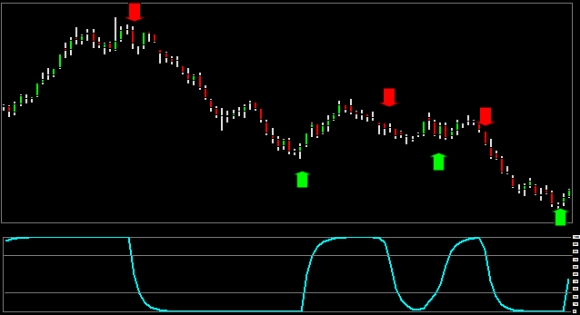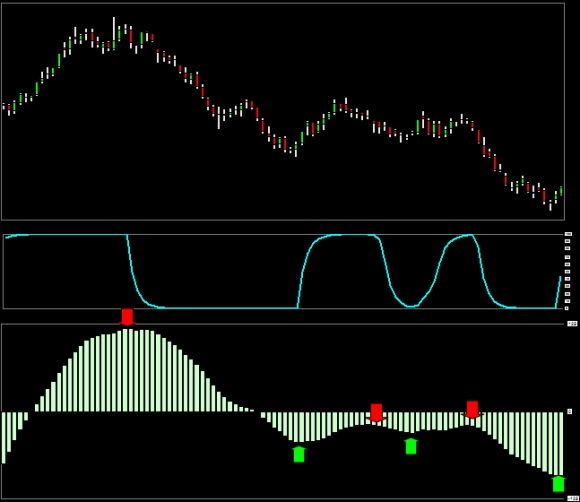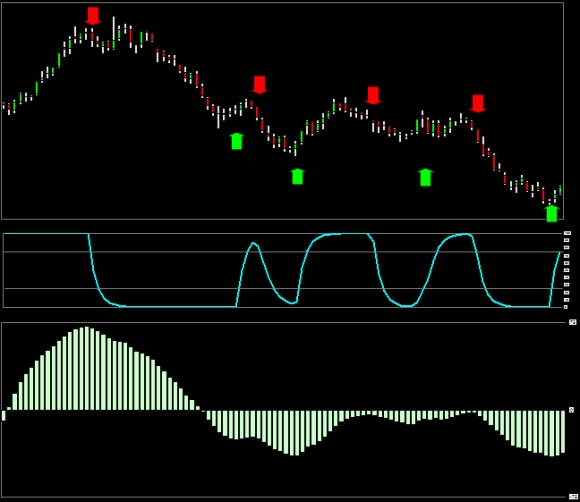STC - Schaff Trend Cycle was created by Doug Schaff. STC combines the advantages of trend-following indicators, cyclic and counter-trend oscillators into one single indicator. Schaff Trend Cycle is not based on Close price (as is the case with other indicators) but its calculation is based on another indicator values. So the technical trader can get Buy and Sell signals excluding many false whipsaws. Moreover STC generates signals soon enough, even before the trend changes. That is the reason why it is considered being one of the best technical analysis indicators ever.
Doug Schaff has revealed the secret of STC construction in February 2008. It combines two of the most popular indicators: MACD and Stochastic oscillator. Schaff has realized that MACD is a strong trend-following indicator. It gives us reliable signals about dominant trend on the market and also generates minimum whipsaws. On the other side it is also considered to be a lagging indicator, because the signals come a bit later (the moving averages themselves are a bit late and MACD calculation is based on them). Stochastic oscillator, on the contrary, is known as counter-trend indicator and generates trading signals much sooner. While Stochastic indicates the market (or cycle) tops or bottoms earlier than the MACD does, it also applies that many of those signals are false. That can lead to many trading losses - so the question is how to eliminate them. It seems that Doug Schaff has found the answer.
STC combines these two indicators into a single one. It gives us signals that are clear (without many whipsaws) but most important - signals that come soon enough (even before the trend changes). Combining these advantages into one single indicator is the reason why STC is so popular on fast, dynamic markets like Forex is and why STC also ranks among the leading indicators.
Schaff Trend Cycle calculation (formula) explained:
1. Calculate one short and one long exponential moving average - EMA from the Close prices (usually EMA23 and EMA50).
2. Calculate the MACD values.
3. Calculate %K from the MACD values (recommended settings are 10 days).
4. Calculate %D (recommended settings are 10 days)
5. Calculate %K from %D (also called as PF)
6. Calculate %D from PF (PFF) or STC.
To explain the calculation in one sentence – we have just calculated the Stochastic over Stochastic over MACD. In step no. 6 we have got the final Schaff Trend Cycle values. The values move in the interval from 0 to 100 points. In the picture below you can see that the moves of the indicator are really very smooth, compared to other technical oscillators (CCI, IMI, RSI or even TSI).

In this example STC indicator has been set to 15 and 80 (short and long exponential moving average), 10 (days for %K calculation) and 3 (days for %K smoothing).
How to trade using Schaff trend cycle indicator? Trading strategy:
1. There are more STC trading strategies a trader can follow. He can trade the crossings of STC with its trigger levels. The trigger levels or signal lines are usually set to 25 and 75 points. If the STC values cross 25 level upwards, it is considered as the end of oversold conditions and we can Buy the asset. If the STC values cross 75 level downwards, it is considered being the end of overbought conditions and we can go Short. Sometimes the indicator is set to 30/70 or even 40/60 trigger levels. It is up to every trader which levels he sets – his decision should be based on the market he follows and the trading strategy he prefers. To eliminate the false signals even more, Doug Schaff suggests going long when the candle following the trigger candle closes above the high of the trigger candle. To go short, the candle following the trigger candle should close below the low of the trigger candle. Trigger candle is being formed at the same time as the STC values rose above 25 or declined below 75 trigger levels.
2. As the STC creates very nice curves, it is not necessary to wait for 25/75 crossings. We can also focus just on the rise and fall of the curve. Should the curve fall (or be at the minimum level), it's better to choose the short trades (sell the asset). Should it rise (or be at its upper level), it's better to prefer the long trades (buy).
3. Very nice signals can also be generated by STC crossings with any chosen Moving average (e.g. ZLEMA, KAMA, TEMA, Hull MA etc.). As for the Forex market, the STC is often combined with its 10-day moving average as the signal line.
Many popular websites gives the information that STC oscillator is much better and much faster than the MACD is. Well, if you think about its construction more, you will find out that STC is based on MACD so the signals are very similar. The main advantage of STC is that it produces signals that are much cleaner – signals you probably would not realize using just the MACD indicator itself. To prove that - have a look at the picture below.

The blue curve stands for STC and the green histogram displays MACD values (which is basically difference between two moving averages). As you might already noticed – the STC reveals the points where two moving averages stop to diverge and start to converge (that is the reason why it is called Moving Average Convergence Divergence). STC calculates the difference between two moving averages and smoothes the final results (using Stochastic oscillator) to get clearer signals.
So if you find a comparison of STC and MACD the differences are mainly caused by various settings of the indicators. STC is mostly based on (23/50) moving averages while MACD basic settings are (12/26). Are you now curious how the indicators would look like in the same chart using the MACD basic settings? Here it is:

As you can see – setting the STC with basic MACD values leads to more signals that are even sooner. That is caused by shorter moving averages (12/26 instead of 15/80) used in this example. The shorter moving averages used for the calculation – the more and sooner signals we get. STC gives us many options for setting it. Great results can be achieved by asymmetric settings, using EMA signal line etc. It's up to every trader how he adapts the indicator and which of the signals he takes into consideration. Almost anyone who has enough time and imagination, can adjust the Schaff trend cycle indicator in such a way, that it can generate much better results than any other conventional (broadly known) technical indicator.
